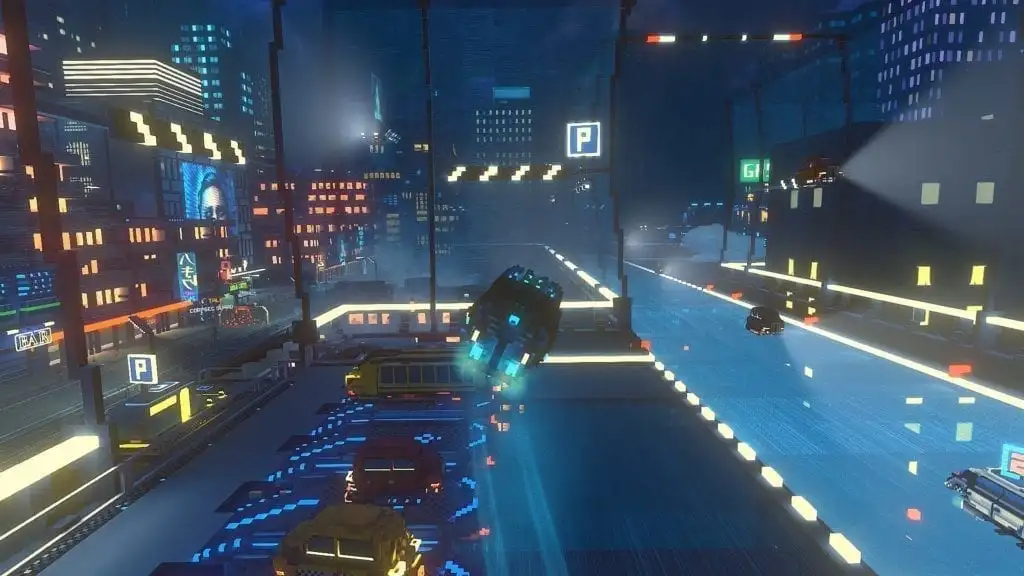The second-ever EGX Berlin wasn’t short on big names. Cyberpunk 2077, Doom Eternal, and Final Fantasy VII Remake were all on display. Hideo Kojima even turned up to talk Death Stranding. But the true gems of the European game fair are the indie games. EGX Berlin was once more full of smaller games with intriguing ideas, and we’ve rounded up the cream of the crop right here. Let’s talk about Cloudpunk, Empires of the Undergrowth, Inkulinati, Curious Expedition 2, and Lost Ember.
Cloudpunk
Rest assured, we have not yet seen all possible permutations of prefix-punk. Cloudpunk stands out with its blocky-but-beautiful visuals that lend the game a slight retro touch. You take on the role of Rania, a driver for a shady delivery company based in the futuristic city of Nivalis.
And what a city it is. Towering, monolithic skyscrapers abound, painted with soft neon lights and ringed by clouds. All manner of flying vehicles provide the traffic on the “roads” of light that criss-cross the skyline. Dreary weather and subdued synth complete the cyberpunk aesthetic.
My hands-on time with the game largely consisted of driving the hovercar, ostensibly to complete a delivery, but in practice, the various nooks and crannies of the city proved more alluring. You can move vertically as well as horizontally and go “off road.” This freedom of movement and urban density creates a sense of mystery around every corner.
Cloudpunk just oozes atmosphere. The city really does feel alive. Cruising, exploring, and watching the traffic go by was a serene pleasure on its own.
Just because you have a car and an open-world city doesn’t mean you’re in store for GTA-style mayhem, though. There’s no combat, but there are parts where Rania leaves the vehicle, moves around, and interacts with various NPCs. Here RPG elements come into play.
Developer Ion Lands tells us that the choices we make with regard to the NPCs we meet, which could include androids and AIs as well as a diverse cast of humans from all social backgrounds, will have lasting consequences on how the story plays out.
If the story lives up to the atmosphere, Cloudpunk will be a welcome indie alternative to 2077‘s more aggressive take on the genre.
Empires of the Undergrowth
Veteran gamers may remember 1991’s SimAnt, a very well-researched strategy game in which players guided their black ant colony through their struggle for survival and expansion. The game was critically well-received and inspired creator Will Wright to represent arguably the second-most successful organisms after ants in his next game, The Sims. Yet, 28 years and four Sims games later, there’s been no official follow up to SimAnt. Enter Slug Disco Studios, developers of Empires of the Undergrowth.
Empires of the Undergrowth stays true to the simulationist feel of the original SimAnt, but it also reminded me of some more fantastical games. You start out with just a handful of workers and a big fat immobile queen. The queen must be kept nourished and safe in order to produce more ants. As you excavate the earth and lay down “buildings” (like resource-dumping points or waste pits), it calls to mind the classic Dungeon Keeper. Once you find tunnels to the surface and begin sending out your ants to fight other bugs for resources, it handles more like an RTS in the vein of StarCraft.
The idiosyncrasies of ant life (like assigning tasks by marking points with pheromones) proved somewhat awkward for yours truly, who is more at home directing soldiers and tanks. Larger enemies such as beetles and spiders can devastate an ill-prepared colony. Thankfully, superior organization and sheer numbers can often win the day.
If you’ve ever been engrossed by a nature documentary about the insect world and found drama in the work and wars of the ants, then Empires of the Undergrowth could be your next obsession. It’s currently for sale as an early access game on Steam, where there’s a free demo available.
Inkulinati
Medieval manuscripts were painstakingly handcrafted and could take weeks or months to finish. So it’s no wonder that monks spiced up the drudgery with amusing (and often rude) doodles to decorate the vellum pages. Inkulinati pits the weird and wonderful creatures of marginalia against each other in turn-based battles. Dog warriors, rabbit archers, flatulent donkey bagpipers, snails, and ecclesiastical cats are among the troops at your disposal.
Each unit comes with different abilities based on their weapon or type. A dog can swing its falchion to hit multiple opponents, a spear has more reach, and the cat bishop can bless and heal troops. True to the ribald humor of the source material, units can expose their butts or fart in some special attacks.
The illuminators (i.e., the artists) can also get in the action. Each illuminator acts as a kind of faction leader with their own abilities and troop types.
I played Inkulinati in hotseat multiplayer mode as Sir Godfrey, an aggressive knight who could smash his gauntlet on the pages to deal damage. My friend, as Lady Hildegard, had special healing abilities.
The 2D battlefields come in various levels of complexity, but the main objective is to collect living ink (used to paint more units or activate abilities) and push the enemy illuminator off the page. All the while, humorous text fills up the pages to narrate battlefield events.
Hotseat mode makes this a great party game to play with guests, but Inkulinati will also have online play and a single-player campaign. Whether you’re a medieval history buff or simply chuckled at Monty Python and the Holy Grail, Inkulinati is one to watch out for.
Curious Expedition 2
Berlin-based indie team Maschinen-Mensch was present to show off Curious Expedition 2, a sequel to its 2016 roguelike set in the Exploration Age. The setting is 19th century adventure in the style of Sir Arthur Conan Doyle and Jules Verne. You’re an intrepid explorer who ventures out into the unknown islands in search of treasure. Procedurally generated fun ensues.
Expect lost temples, ancient relics (and accompanying traps and curses), suspicious tribes, and dangerous creatures. If you succeed, fortune and glory await you when you return to your Explorer’s Club. There are a few of these to choose from, with different gameplay effects. If you fail, well, there’s another chancer willing to take your place.
Curious Expedition 2 ditches the pixel graphics of its predecessor for a more detailed drawn-art style. It’s colorful and cartoonish, but don’t let that fool you — curiosity still kills the cat. Resource management is key to survival. Travel drains your party’s sanity meter, but it can be topped up with items, notably alcohol. Encounters with wild beasts or other enemies can yield loot (like animal skins and meat) but also be a risky drain on one’s resources.
Curious Expedition 2 uses special dice to resolve combat. The presence of RNG means even one’s best laid plans can go awry. As anyone who’s played Dwarf Fortress knows well, this often just makes things more fun.
My own demo expedition got off to a good start, with successful contact with natives and the recruitment of a local warrior. There was trading and the discovery of several mystic sites and interesting curios. But things began to take a dark turn when one of my original companions became surly and resentful. Then I realized I had been too eager to trade my whiskey for local trinkets. After these small triumphs and mishaps, an emergent story was already shaping and I could see the potential of many more.
Maschinen-Mensch was on hand to take down feedback and feature requests, but even at this unfinished stage Curious Expedition 2 looks very compelling. The curious can expect the call to adventure later this year.
Lost Ember
Lost Ember presents a post-apocalyptic world, but it’s a beautiful one. Humanity’s reign has passed, leaving nature to take over. Our main protagonist is a wolf accompanied by a sentient spark that communicates clues about the past and humanity’s downfall. But even this swift hunter cannot traverse the more challenging environments in the game. Thankfully, your glowing companion also enables you to take the shape of any other animal you might happen to meet.
For example, you might become a fish to swim, a hummingbird to fly, or a mole to dig underground. Even apparently weak forms such as a tiny duckling are a joy to play around with. Lost Ember‘s environments are gorgeous and bursting with life. It’s a pleasure to just roam around and enjoy the view and the emotional soundtrack.
There’s no combat to speak of; it’s just about exploration and finding locations that progress the story. But the journey is more interesting than that of the average walking simulator thanks to the different perspectives and locomotion of each animal.
That doesn’t mean that Lost Ember is all sweetness and light. Reaching story checkpoints reveals visions of the past and the fate of the missing humans. Without spoiling too much, there’s more than a hint of tragedy.
But the touch of melancholy makes the beauty of Lost Ember‘s natural world more emotionally affecting, and I was left intrigued to discover more. There’s not long to wait — Lost Ember is set to release November 22.








Published: Nov 8, 2019 8:44 PM UTC